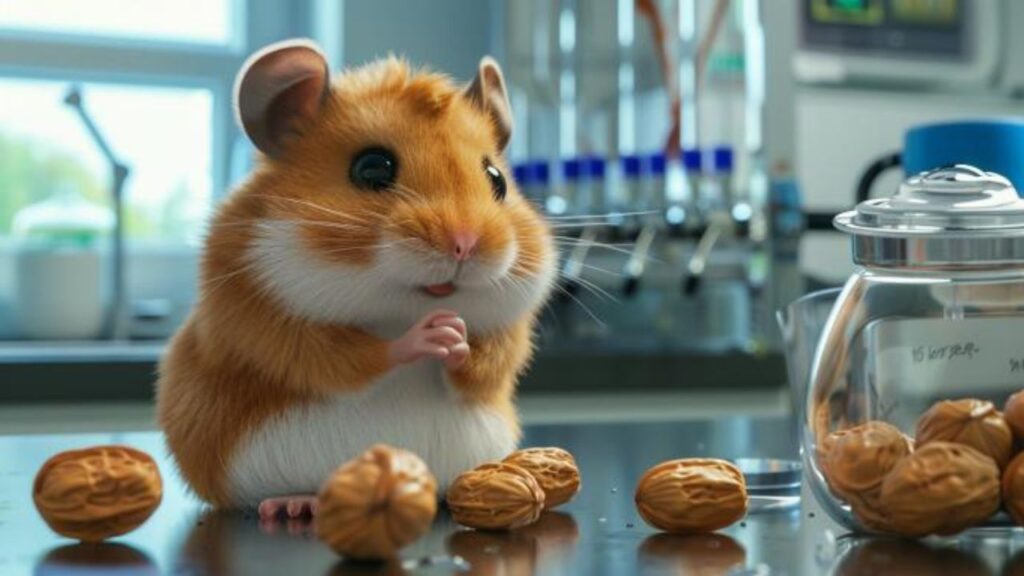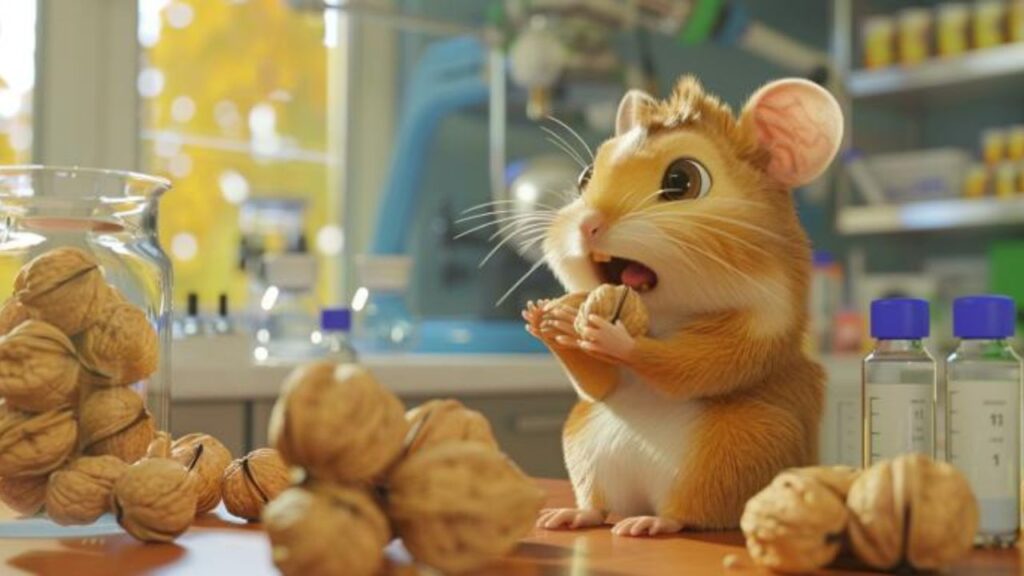TL;DR Summary
Yes, hamsters can safely enjoy walnuts as an occasional treat in their diet. However, it’s important to serve walnuts in small, manageable pieces and ensure they are unsalted and unflavored to avoid health risks. While walnuts provide beneficial nutrients like omega-3 fatty acids and protein, they should be given sparingly due to their high fat content, and only as part of a balanced diet. Always introduce walnuts gradually and monitor your hamster for any signs of digestive distress or allergies. Remember, moderation and careful preparation are key to safely incorporating walnuts into your hamster’s diet. Remember, a happy hamster is a wheel-y happy you!
Hamsters, with their endearing antics and tiny paws, are beloved pets in many households. As responsible pet owners, it’s crucial to understand not only the basics of hamster care but also the finer points of their dietary needs. One common question that arises is whether it’s safe to share human snacks, like walnuts, with these little creatures. This article will delve into the safety and nutritional implications of feeding walnuts to hamsters, helping owners make informed decisions about their furry friend’s treats.
The Importance of Knowing Safe Treats for Hamsters
When it comes to feeding hamsters, what seems harmless might not always be safe. Small as they are, hamsters have specific nutritional requirements and digestive capabilities. Introducing the wrong foods can lead to health problems ranging from obesity to digestive distress. Therefore, understanding which treats are beneficial and which could be harmful is essential for maintaining the health and happiness of your hamster. This knowledge not only ensures a well-balanced diet but also prevents potential dietary mishaps that could adversely affect your pet’s well-being.
Evaluating Nutritional Treats for Optimal Hamster Health
This section will focus on assessing the suitability of various treats, including walnuts, within a hamster’s diet. It will emphasize the importance of aligning treats with the nutritional needs of hamsters, ensuring that each food choice contributes positively to their overall health and dietary balance. Understanding the nutritional content and potential health impacts of treats like walnuts is key to creating a diverse and safe diet for these small pets.
Overview of Walnuts

Walnuts are a popular type of tree nut known for their distinctive wrinkled appearance and rich, slightly bitter flavor. As a staple in many diets around the world, walnuts are not only a versatile ingredient in culinary uses but also a powerhouse of nutritional benefits.
General Description of Walnuts and Their Nutritional Profile
Walnuts belong to the tree nut family and are particularly noted for their unique brain-like shape. They are the edible seeds of the Juglans genus trees and are mostly harvested from the Persian or English walnut tree (Juglans regia). Typically consumed raw, roasted, or as part of various dishes, walnuts are highly regarded for their nutritional value.
Nutritionally, walnuts are dense in energy and rich in healthy fats. They contain significant amounts of omega-3 fatty acids, specifically alpha-linolenic acid (ALA), which is a plant-based essential fatty acid that the body cannot synthesize. Besides healthy fats, walnuts are a good source of protein, fiber, and are packed with antioxidants. They also provide important vitamins and minerals, including magnesium, phosphorus, and vitamin B6.
Benefits of Walnuts in a General Diet
The consumption of walnuts has been linked to numerous health benefits, particularly for humans:
- Heart Health: The omega-3 fatty acids in walnuts contribute to cardiovascular health by helping to reduce bad cholesterol levels and inflammation, which are risk factors for heart disease.
- Brain Function: Walnuts are often dubbed as “brain food,” not only for their cerebral appearance but also for their high levels of DHA, a type of Omega-3 fatty acid known to aid cognitive performance and prevent cognitive decline.
- Weight Management: Despite their high calorie content, walnuts are rich in fiber and protein, which can help people feel fuller for longer, aiding in weight management.
- Anti-inflammatory Properties: The antioxidants and other plant compounds found in walnuts help combat oxidative stress and reduce inflammation, a key driver of many chronic diseases.
Understanding these benefits highlights why walnuts are valued in human diets and sets the stage for exploring their suitability for hamsters. This nutritional background serves as a foundation for assessing whether such a nutrient-dense nut can be a safe and beneficial addition to a hamster’s diet.
Are Walnuts Safe for Hamsters?

When considering adding a new element to a hamster’s diet, it is crucial to evaluate both the potential benefits and risks. Walnuts, while nutritionally beneficial for humans, present a unique set of considerations when it comes to hamster health.
Detailed Analysis of Walnuts’ Safety for Hamster Consumption
Walnuts are non-toxic to hamsters, which means they can be eaten without immediate risk of poisoning. However, their high fat content and large size make them a treat that should be offered only in moderation and with certain precautions.
High Fat Content: Walnuts are rich in fats, particularly polyunsaturated fats, which, while healthy for humans, can be excessive for hamsters if fed in large quantities. Hamsters require a balanced diet, and too much fat can lead to obesity and associated health problems like diabetes and heart issues.
Hard Texture: The hard texture of walnuts can also be challenging for hamsters, especially for younger or smaller breeds. There is a risk of choking or dental problems if the nuts are not properly prepared before offering them to your pet.
Potential Health Benefits of Feeding Walnuts to Hamsters
Despite these concerns, incorporating small amounts of walnuts into a hamster’s diet can offer benefits:
- Omega-3 Fatty Acids: Like in humans, the omega-3 fatty acids found in walnuts can help improve the coat and skin health of hamsters, giving them a shiny and healthy appearance.
- Protein and Fiber: The protein content in walnuts can contribute to muscle growth and repair, while fiber can aid in digestion, though both are available in safer, more suitable forms in other foods.
Potential Risks Associated with Feeding Walnuts to Hamsters
- Obesity and Related Diseases: Due to their high caloric content, walnuts should be given sparingly to prevent weight gain and its complications.
- Nutritional Imbalance: Relying too heavily on walnuts for dietary fat or protein can lead to an imbalance, as walnuts lack certain essential nutrients hamsters need, which are found in their standard diets.
- Choking Hazard: Pieces of walnuts must be small enough to prevent choking or dental issues, making preparation key.
In conclusion, while walnuts can be a safe treat for hamsters when given appropriately, they should only make up a very small part of the diet. The key to safely including walnuts is moderation, careful preparation, and ongoing monitoring of the hamster’s health and weight. This ensures that the benefits can be enjoyed without risking the potential downsides.
How to Safely Introduce Walnuts to Your Hamster’s Diet

Introducing walnuts, or any new food, into a hamster’s diet requires careful consideration to ensure that it’s done safely and healthily. Here’s a step-by-step guide to help you introduce walnuts into your hamster’s feeding regimen in a way that maximizes potential benefits while minimizing risks.
Step-by-Step Guide on Introducing Walnuts to Hamsters
- Start with Small Quantities: Begin by offering your hamster a tiny piece of walnut. It should be no larger than a couple of millimeters squared – about the size of a small pea. This small amount helps you observe how your hamster reacts without overwhelming their digestive system.
- Proper Preparation: Ensure the walnut is fresh and unsalted. Salted or flavored nuts are harmful to hamsters. Remove the walnut shell completely to avoid any risk of injury or choking.
- Hand Feeding: Initially, try hand-feeding the walnut piece to your hamster. This not only allows you to bond with your pet but also lets you closely monitor how they chew and ingest the nut.
- Observe the Reaction: After feeding, watch your hamster for any signs of digestive distress or allergic reactions. Look for symptoms such as lethargy, diarrhea, or changes in eating habits over the next 24-48 hours.
- Gradual Integration: If your hamster shows no adverse reactions and seems to enjoy the walnut, you can gradually make it a regular treat. Continue to monitor your pet’s health as you gradually increase the portion size.
Recommended Portion Sizes and Frequency of Feeding
- Portion Size: A safe portion of walnut for a hamster is about the size of a small pea. Given the high fat and calorie content of walnuts, this is sufficient.
- Frequency of Feeding: Walnuts should be fed to hamsters only occasionally, not more than once a week. This frequency ensures that your hamster benefits from the nutrients in walnuts without the risk of obesity or nutritional imbalance.
Additional Tips
- Mix It Up: Incorporate other safe nuts and seeds in small amounts to provide variety and a balanced mix of nutrients.
- No Salt or Seasonings: Always use plain, unsalted walnuts. Salt and other seasonings can be very harmful to hamsters.
- Storage: Store walnuts in a cool, dry place to maintain their freshness. Rancid nuts can be harmful to your hamster.
By following these guidelines, you can safely introduce walnuts into your hamster’s diet as a special treat. This approach ensures that your hamster enjoys the new addition to their diet while maintaining overall health and well-being.
Whisker Tips: Best Practices for Feeding Hamsters Walnuts

Adding walnuts to your hamster’s diet can provide a fun and enriching experience for both of you, but it’s crucial to do so with care. Here are some practical tips to ensure that walnuts are a safe and healthy treat for your hamster.
Practical Advice on Offering Walnuts to Hamsters
Preparation
- Chop Carefully: Always chop walnuts into small, manageable pieces before offering them to your hamster. This helps prevent choking hazards and ensures that the nuts are easy for your hamster to handle and eat.
- Unsalted and Unflavored: Use only raw, unsalted, and unflavored walnuts. Many commercially available nuts come with added salts or seasonings that are harmful to hamsters.
- Freshness Is Key: Ensure that the walnuts are fresh and not stale or rancid, as spoiled nuts can cause health problems for your hamster.
Storage
- Airtight Containers: Store walnuts in airtight containers to keep them fresh longer.
- Cool and Dry Location: Keep the container in a cool, dry place away from direct sunlight, which can help prevent the nuts from becoming rancid.
Additional Advice on Maintaining Dietary Balance and Monitoring Hamster Health
Maintaining Dietary Balance
- Treat, Not Staple: Remember that walnuts should only be a small part of your hamster’s diet. Their main diet should consist of high-quality hamster pellets, which are specially formulated to meet their nutritional needs.
- Variety: Along with walnuts, occasionally introduce other safe fruits, vegetables, and seeds to provide a balanced mix of nutrients. This not only keeps your hamster healthy but also mentally stimulated and happy.
Monitoring Hamster Health
- Watch for Allergic Reactions: While rare, it’s possible for hamsters to have allergies to specific foods, including walnuts. If you notice any signs of allergic reactions such as swelling, excessive scratching, or respiratory distress, discontinue feeding and consult a veterinarian.
- Observe Behavioral Changes: After introducing walnuts, keep an eye on your hamster’s behavior and stool. Changes in activity levels or diarrhea can indicate that walnuts might not agree with your hamster.
By following these “Whisker Tips,” you can safely incorporate walnuts into your hamster’s diet as a delightful treat that enhances their overall health and well-being. These best practices help ensure that your little friend enjoys their nuts in the healthiest way possible!
Conclusion

Walnuts can be a nutritious and enjoyable treat for hamsters when introduced and administered correctly. Throughout this article, we have explored the various aspects of feeding walnuts to hamsters, from the nutritional benefits and potential risks to the best practices for safe introduction and feeding.
Recap of the Key Points Discussed
- Safety and Preparation: Walnuts are safe for hamsters in small amounts but must be prepared properly by ensuring they are unsalted, unflavored, and finely chopped to avoid health risks.
- Nutritional Benefits: While walnuts provide valuable nutrients such as omega-3 fatty acids and proteins, they should only complement a balanced diet, not replace it.
- Moderation is Key: Due to their high fat content, walnuts should be given sparingly to prevent obesity and related health issues.
- Monitoring Health: Always observe your hamster’s reaction to new foods like walnuts, watching for any signs of digestive distress or allergies.
Final Thoughts on Incorporating Walnuts into a Hamster’s Diet Responsibly
Adding walnuts to your hamster’s diet offers a way to enrich their feeding routine with a healthy snack, provided it is done with care. The introduction should be gradual, and the amounts kept small to maintain the nutritional balance and ensure your hamster’s diet remains diverse and suitable for their needs.
Signature Closing
As always, the health and happiness of your furry friend are paramount. Careful dietary choices play a crucial role in fostering a long and joyful life for your hamster. Remember, a happy hamster is a wheel-y happy you!




